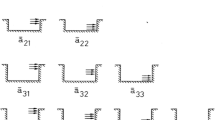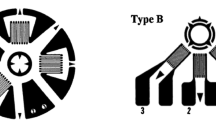Abstract
A finite-element technique to analyze the data obtained by the hole-drilling strain-gage method is presented. In this study, residual stresses are assumed as initial stresses existing in the structural material or component. It is also assumed that the elimination of the initial stresses in the region of the drilled hole changes the measured strains. After putting initial stresses into displacement finite-element equations and comparing the stiffness matrix and the initial stresses matrix with those of the previous increment, equations relating unknown initial stresses and measured strains were obtained. By solving these equations, residual stresses were obtained. In this paper three examples are studied. In the first two examples, calibration constants C1 to be used in determining residual stress were calculated which varied with depth. In the third example, the data obtained by using the hole-drilling method are analyzed. All examples show good agreement with previous studies. Using the present method allows greater flexibility of choice of specimen shape, materials, and experimental procedure than would be possible if only analytic solutions were used.
Similar content being viewed by others
References
Kelsey, R.A., “Measurement of Non-uniform Residual Stresses by the Hole Drilling Method,”Proc. SESA XIV (1),181–194 (1956).
Endler, N.J.R. andVigness, I., “Hole-drilling Strain-gage Method of Measuring Residual Stresses,”Proc. SESA XXIII (2),577–586 (1966).
Mathar, J., “Determination of Initial Stresses by Measuring the Deformation Around Drilled Holes,”Trans. ASME,56 (4),249–254 (1934).
Nawwar, A.M., McLachlan, K. andSchewchuk, J., “A Modified Hole-drilling Technique for Determining Residual Stresses in Thin Plates,”Experimental Mechanics,23,226–232 (1976).
Schajer, G.S., “Application of Finite Element Calculations to Residual Stress Measurements,”J. Eng. Mat. and Tech.,103,157–163 (April 1981).
Boag, J.M. and Flaman, M.T., “Comparison of Hole Drilling Residual Stress Analysis Techniques,” Proc. 1987 SEM Spring Conf. on Exp. Mech. (1987).
Flaman, M.T. andManning, B.H., “Determination of Residual Stress Variation with Depth by the Hole Drilling Method,”Experimental Mechanics,25 (9),205–207 (Sept. 1985).
Measurements Group Inc., “Measurement of Residual Stresses by the Hole-drilling Strain-gauge Method,” Measurements Group Tech. Note 503-2 (1986).
Author information
Authors and Affiliations
Rights and permissions
About this article
Cite this article
Shaw, D., Chen, H.Y. A finite-element technique to analyze the data measured by the hole-drilling method. Experimental Mechanics 30, 120–123 (1990). https://doi.org/10.1007/BF02410236
Received:
Revised:
Issue Date:
DOI: https://doi.org/10.1007/BF02410236




